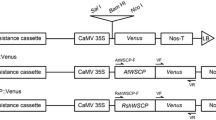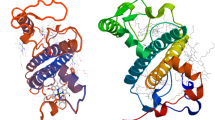Abstract
Water-soluble chlorophyll protein (WSCP) has been found in many Brassicaceae, most often in leaves. In many cases, its expression is stress-induced, therefore, it is thought to be involved in some stress response. In this work, recombinant WSCP from Arabidopsis thaliana (AtWSCP) is found to form chlorophyll-protein complexes in vitro that share many properties with recombinant or native WSCP from Brassica oleracea, BoWSCP, including an unusual heat resistance up to 100°C in aqueous solution. A polyclonal antibody raised against the recombinant apoprotein is used to identify plant tissues expressing AtWSCP. The only plant organs containing significant amounts of AtWSCP are the gynoecium in open flowers and the septum of developing siliques, specifically the transmission tract. In fully grown but still green siliques, the protein has almost disappeared. Possible implications for AtWSCP functions are discussed.





Similar content being viewed by others
Abbreviations
- AtWSCP:
-
WSCP from Arabidopsis thaliana
- BoWSCP:
-
WSCP from Brassica oleracea
- BSA:
-
Bovine serum albumin
- CD:
-
Circular dichroism
- Chl:
-
Chlorophyll
- Chlide:
-
Chlorophyllide
- PAGE:
-
Polyacrylamide gel electrophoresis
- WSCP:
-
Water-soluble chlorophyll protein
References
Annamalai P, Yanagihara S (1999) Identification and characterization of a heat-stress induced gene in cabbage encodes a Kunitz type protease inhibitor. J Plant Physiol 155:226–233
Bendtsen JD, Nielsen H, von Heijne G, Brunak S (2004) Improved prediction of signal peptidases: SignalP 3.0. J Mol Biol 340:783–795
Bujard H, Gentz R, Lanzer M, Stueber D, Mueller M, Ibrahimi I, Haeuptle MT, Dobberstein B (1987) A T5-promoter-based transcription-translation system for the analysis of protein expression in vivo and in vitro. Methods Enzymol 155:416–433
Crawford BC, Yanofsky MF (2008) The formation and function of the female reproductive tract in flowering plants. Curr Biol 18:R972–R978
Desclos M, Dubousset L, Etienne P, Le Caherec F, Satoh H, Bonnefoy J, Ourry A, Avice JC (2008) A proteomic profiling approach to reveal a novel role of Brassica napus drought 22 kD/water-soluble chlorophyll-binding protein in young leaves during nitrogen remobilization induced by stressful conditions. Plant Physiol 147:1830–1844
Downing W, Mauxion F, Fauvarque M, Reviron M, de Vienne D, Vartanian N, Giraudat J (1992) A Brassica napus transcript encoding a protein related to the Künitz protease inhibitor family accumulates upon water stress in leaves, not in seeds. Plant J 2:685–693
Halls CE, Rogers SW, Oufattole M, Ostergard O, Svensson B, Rogers JC (2006) A Kunitz-type cysteine protease inhibitor from cauliflower and Arabidopsis. Plant Sci 170:1102–1110
Horigome D, Satoh H, Itoh N, Mitsunaga K, Oonishi I, Nakagawa A, Uchida A (2007) Structural mechanism and photoprotective function of water-soluble chlorophyll-binding protein. J Biol Chem 282:6525–6531
Hörtensteiner S (2006) Chlorophyll degradation during senescence. Annu Rev Plant Biol 57:55–77
Hughes JL, Razeghifard R, Logue M, Oakley A, Wydrzynski T, Krausz E (2006) Magneto-optic spectroscopy of a protein tetramer binding two exciton-coupled chlorophylls. J Am Chem Soc 128:3649–3658
Ilami G, Nespoulous C, Huet JC, Vartanian N, Pernollet JC (1997) Characterization of Bnd22, a drought-induced protein expressed in Brassica napus leaves. Phytochemistry 45:1–8
Isayenkov S, Mrosk C, Stenzel I, Strack D, Hause B (2005) Suppression of allene oxide cyclase in hairy roots of Medicago trunculata reduces jasmonate levels and the degree of mycorrhization with Glomus intraradices. Plant Physiol 139:1401–1410
Kamimura Y, Mori T, Yamasaki T, Katoh S (1997) Isolation, properties and a possible function of a water soluble chlorophyll a/b protein from Brussels sprouts. Plant Cell Physiol 38:133–138
Lopez F, Vansuyt G, Fourcroy P, Cassedelbart F (1994) Accumulation of a 22-kDa protein and its messenger RNA in the leaves of Raphanus sativus in response to salt stress and water deficit. Physiol Plant 91:605–614
Nishio N, Satoh H (1997) A water-soluble chlorophyll protein in cauliflower may be identical to Bnd22, a drought-induced, 22-kilodalton protein in rapeseed. Plant Physiol 115:841–846
Oku T, Yoshida M, Tomita G (1972) Heat stability of the phototransforming activity of Chenopodium chlorophyll protein. Plant Cell Physiol 13:183–186
Paulsen H, Rümler U, Rüdiger W (1990) Reconstitution of pigment-containing complexes from light-harvesting chlorophyll a/b-binding protein overexpressed in E. coli. Planta 181:204–211
Peter G, Thornber J (1991) Electrophoretic procedures for fractionation of photosystems I and II pigment proteins of higher plants and for determination of their subunit composition. In: Rogers L (ed) Methods in plant biochemistry. Academic Press, New York, pp 195–210
Pieper J, Rätsep M, Trostmann I, Paulsen H, Renger G, Freiberg A (2011a) Excitonic energy level structure and pigment-protein interactions in the recombinant water-soluble chlorophyll protein. I. Difference fluorescence line-narrowing. J Phys Chem B 115:4042–4052
Pieper J, Rätsep M, Trostmann I, Schmitt FJ, Theiss C, Paulsen H, Eichler HJ, Freiberg A, Renger G (2011b) Excitonic energy level structure and pigment-protein interactions in the recombinant water-soluble chlorophyll protein. II. Spectral hole-burning experiments. J Phys Chem B 115:4053–4065
Porra R, Thompson W, Kriedemann P (1989) Determination of accurate extinction coefficients and simultaneous equations for assaying chlorophylls a and b extracted with four different solvents: verification of the concentration of chlorophyll standards by atomic absorption spectroscopy. Biochim Biophys Acta 975:384–394
Reinbothe C, Satoh H, Alcaraz J, Reinbothe S (2004) A novel role of water-soluble chlorophyll proteins in the transitory storage of chorophyllide. Plant Physiol 134:1355–1365
Renger T, Trostmann I, Theiss C, Madjet ME, Richter M, Paulsen H, Eichler HJ, Knorr A, Renger G (2007) Refinement of a structural model of a pigment-protein complex by accurate optical line shape theory and experiments. J Phys Chem B 111:10487–10501
Renger G, Pieper J, Theiss C, Trostmann I, Paulsen H, Renger T, Eichler HJ, Schmitt F (2011) Water soluble chlorophyll binding protein of higher plants: a most suitable model system for basic analyses of pigment–pigment and pigment-protein interactions in chlorophyll protein complexes. J Plant Physiol 168:1462–1472
Reviron M, Vartanian N, Sallantin M, Huet J, Pernollet J, de Vienne D (1992) Characterization of a novel protein induced by progressive or rapid drought and salinity in Brassica napus leaves. Plant Physiol 100:1486–1493
Satoh H, Nakayama K, Okada M (1998) Molecular cloning and functional expression of a water-soluble chlorophyll protein, a putative carrier of chlorophyll molecules in cauliflower. J Biol Chem 273:30568–30575
Satoh H, Uchida A, Nakayama K, Okada M (2001) Water-soluble chlorophyll protein in Brassicaceae plants is a stress-induced chlorophyll-binding protein. Plant Cell Physiol 42:906–911
Schmidt K, Fufezan C, Krieger-Liszkay A, Satoh H, Paulsen H (2003) Recombinant water-soluble chlorophyll protein from Brassica oleracea var. botrys binds various chlorophyll derivatives. Biochemistry 42:7427–7433
Schmitt FJ, Trostmann I, Theiss C, Pieper J, Renger T, Fuesers J, Hubrich EH, Paulsen H, Eichler HJ, Renger G (2008) Excited state dynamics in recombinant water-soluble chlorophyll proteins (WSCP) from cauliflower investigated by transient fluorescence spectroscopy. J Phys Chem B 112:13951–13961
Scutt CP, Vinauger-Douard M, Fourquin C, Ailhas J, Kuno N, Uchida K, Gaude T, Furuya M, Dumas C (2003) The identification of candidate genes for a reverse genetic analysis of development and function in the Arabidopsis gynoecium. Plant Physiol 132:653–665
Theiss C, Trostmann I, Andree S, Schmitt FJ, Renger T, Eichler HJ, Paulsen H, Renger G (2007) Pigment-pigment and pigment-protein interactions in recombinant water-soluble chlorophyll proteins (WSCP) from cauliflower. J Phys Chem B 111:13325–13335
Tung CW, Dwyer KG, Nasrallah ME, Nasrallah JB (2005) Genome-wide identification of genes expressed in Arabidopsis pistils specifically along the path of pollen tube growth. Plant Physiol 138:977–989
Wellmer F, Riechmann J, Alves-Ferreira MME (2004) Genome-wide analysis of spatial gene expression in Arabidopsis flowers. Plant Cell 16:1314–1326
Zimmermann P, Hirsch-Hoffmann M, Hennig L, Gruissem W (2004) GENEVESTIGATOR: Arabidopsis microarray database and analysis toolbox. Plant Physiol 136:2621–2632
Acknowledgments
We thank Andrea Weil for her help with the bacterial expression and analysis of AtWSCP. This work was funded in part by the Deutsche Forschungsgemeinschaft (Pa 324/8-1 to H.P.).
Author information
Authors and Affiliations
Corresponding author
Electronic supplementary material
Below is the link to the electronic supplementary material.
Rights and permissions
About this article
Cite this article
Bektas, I., Fellenberg, C. & Paulsen, H. Water-soluble chlorophyll protein (WSCP) of Arabidopsis is expressed in the gynoecium and developing silique. Planta 236, 251–259 (2012). https://doi.org/10.1007/s00425-012-1609-y
Received:
Accepted:
Published:
Issue Date:
DOI: https://doi.org/10.1007/s00425-012-1609-y




